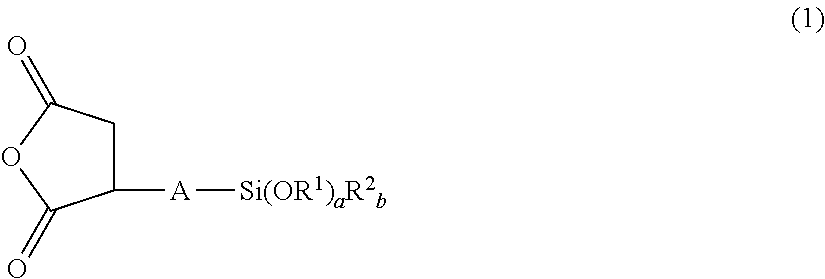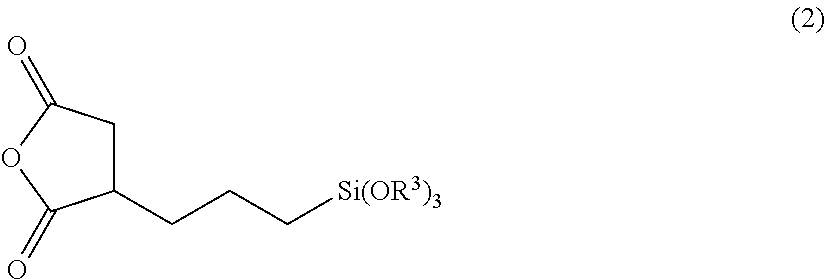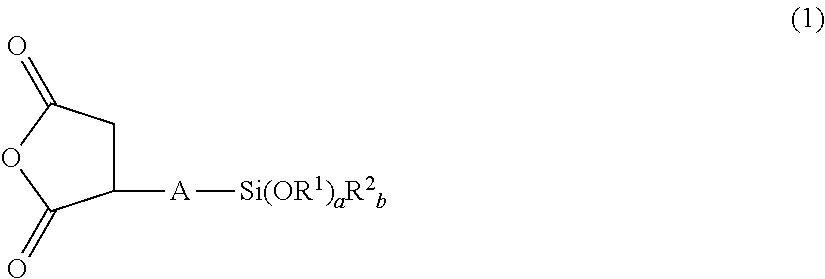Hydrophilized substrate, dispersion, and making method
a technology of hydrophilicity and substrate, applied in the field of hydrophilicity substrate, can solve the problems of decreasing the degree of dispersion with time, color difference between appearance and coat, and ineffective hydrophilicity treatment of conventional surfactants and water-soluble polymers, etc., and achieve excellent hydrophilicity and avoid skin irritation and other unwanted effects
- Summary
- Abstract
- Description
- Claims
- Application Information
AI Technical Summary
Benefits of technology
Problems solved by technology
Method used
Image
Examples
example 1
[1] Surface Treatment of Powder
[0044]A 1-L three-neck flask equipped with a stirrer, thermometer, ester adaptor and Dimroth condenser was charged with 50.0 g of titanium oxide powder (MT-100SA by TAYCA Corporation, average primary particle size 15 nm, alumina-silica surface treatment), 3.80 g of water, 3.00 g (1.15×10−2 mole) of a hydrolyzable silyl group-containing acid anhydride compound having the structural formula (3), and 100 g of acetone.
[0045]
[0046]The contents were mixed and stirred for 30 minutes at room temperature. The flask was heated to about 60° C. for distilling off acetone, after which with stirring interrupted, heat treatment was continued at 105° C. for 3 hours. Cooling to room temperature resulted in a conglomerate sample which was ground on a mortar into particles.
[2] Ring-Opening Due to Hydrolysis of Acid Anhydride Moiety and Neutralization
[0047]A 1-L three-neck flask equipped with a stirrer, thermometer, and Dimroth condenser was charged with the entire amount...
example 2
[0050]The same procedures as in Example 1 were repeated except that the amount of triethanolamine added in stage [2] was changed to 6.86 g (4.60×10−2 mole).
example 3
[0051]The same procedures as in Example 1 were repeated except that in stage [1], the powder was changed to zinc oxide powder (MZ-500 by TAYCA Corporation, average primary particle size 20-30 nm, no surface treatment), and the amount of the hydrolyzable silyl group-containing acid anhydride compound having formula (3) was changed to 1.50 g (5.73×10−3 mole). In stage [2], 0.58 g (5.73×10−3 mole) of triethylamine was added as the base.
PUM
| Property | Measurement | Unit |
|---|---|---|
| diameter | aaaaa | aaaaa |
| impurities | aaaaa | aaaaa |
| degree of dispersion | aaaaa | aaaaa |
Abstract
Description
Claims
Application Information
 Login to View More
Login to View More - R&D
- Intellectual Property
- Life Sciences
- Materials
- Tech Scout
- Unparalleled Data Quality
- Higher Quality Content
- 60% Fewer Hallucinations
Browse by: Latest US Patents, China's latest patents, Technical Efficacy Thesaurus, Application Domain, Technology Topic, Popular Technical Reports.
© 2025 PatSnap. All rights reserved.Legal|Privacy policy|Modern Slavery Act Transparency Statement|Sitemap|About US| Contact US: help@patsnap.com



